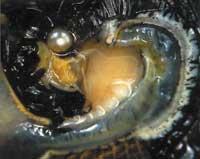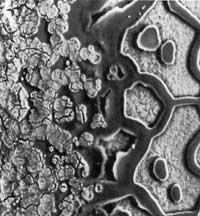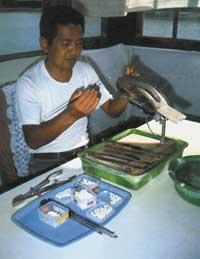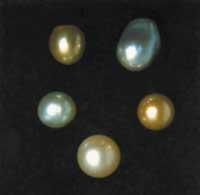Cleopatra, pearls and luxury
Very curious jewelry

It seems that mollusks were born 530 million years ago, and from that moment until today they have been able to produce pearls. Any shell molluscum is capable of making pearls; in short, both the shell and pearls have the same ingredients. This ability, however, is only used by a few. Therefore, pearls have always been very scarce.
The largest of the findings is now about 220-230 million years. In nature, only one in 10,000 molluscs produces pearls. However, pearl manufacturers have developed various techniques to increase the number of bivalve pearl producers. This is how the largest pearl production ever has been achieved.
The shell of molluscs consists mainly of calcium carbonate. In it you can distinguish three layers: the outer layer (called periostra) is thin and apparently branched; the central one has a prismatic structure; and the inner layer is iridescent and is formed by mother-of-pearl.
As the study techniques have been developed, the formation of this shell has been better understood by crystallizing calcium carbonate in similar polygonal flat crystals. The variety of forms of placement of crystals varies from species to species: it can appear as a column, as stairs, forming pyramids, etc. This forms the shell that covers the soft body of the animal. All these crystals are surrounded by an organic matrix of conquering, that is, of periodicity. Under this layer of glass is the mother pearl or mother pearl.

The introduction of a rare fraction inside the body surface (a gill of sand, a piece of shell from another animal...) covers the strange mollusk body with thousands of layers formed by calcium carbonate and conquers, in short, a defensive mechanism. In this way it is possible to isolate the foreign body and not damage the inside of the animal. The internal structure of Perl is therefore the same as that of the shell, in fact, it is a shell formed around the strange core. When pearls are formed naturally, it is usually due to the introduction of some sand gravel (or parasite or larva of a basket) inside the wild oyster. However, for the production of cultured pearls in the cultivation fractions of shells are introduced into the body cavity of the oyster. However, to produce freshwater oyster pearls, shell particles are replaced by textile fractions of another mollusc.
As already indicated, the cultivation of pearls has experienced a great boom in recent years. There are more and more techniques to push oysters to make pearls. The introduction of the nucleus into the oyster through the nucleation process produces deadly stress, as the oyster leaflets must be opened with force. Therefore, operators need a great ability to do the work quickly and correctly, while minimizing blood loss and dehydration, as oysters cannot remain open for a long time. If this process exceeds twenty minutes, mollusks die.
In addition, it should be noted that the leaflets of oysters open very little, by a physical limit of the animal, so the operator will nucleate without just seeing anything inside the oyster. The oysters of two or three years leave the sea, nuclean and return to the sea, tucked into baskets hanging on floating platforms. These platforms move frequently to protect oysters from predators and unfavorable temperatures. After a period of care of between three and six years, oysters are collected to extract pearls and classify them for their quality.
Although mollusks are the ones that do the most work in the formation of pearls, the human being constantly strives to improve the quality or to obtain a lineage or characteristic that pearls do not have for themselves, although the methods devised for this are harmful to the animal. However, natural pearls remain the most appreciated.

Despite these pearl breeding techniques, annual production of defective pearls is relatively low. For example, in Japan, half of the nuclear oysters do not produce pearls, 25% are very bad pearls and 20% are medium-low quality, although they are sold. Therefore, of the total oysters, only 5% consider classified pearls satisfactory. This percentage varies from species to species and people, but pearl defects are in all exceptional cases.
At any time, pearls are always attractive
Apparently, the admiration of the knob began in the time of the Romans and the Byzantines. All civilizations have given a very different importance to pearls. It seems to be the XIX. That the Japanese who before the twentieth century were looking for the shell did not pay attention to the bare pearls. Polynesians grew pearly oysters, but to take advantage of shells (and not pearls). Pearls were used by children in caniques. However, closer to us, one of the reasons Julius Caesar had to invade Britain was the desire to take the pearls.
That's what Pliny the Elder tells us, at least. 23-79) in his well-known Natural History. He wrote that in the seas of Rome there were no pearls and, although they were discovered, they were small and of low quality. Therefore, in the words of Pliny the Elder, Julius Caesar decorated the pearl in English, a temple built in honor of the Goddess Venus.
During the Middle Ages and the Renaissance, the European church and nobility endowed themselves with pearls to adorn costumes, jewelry and ornaments. Most of the pearls then were produced by fresh water oysters in Germany, Scandinavia and Russia.
Moreover, in the Renaissance pearls were the precious stones of Europe. When networks of merchants were established as a consequence of American colonization, the XVI. In the 20th century, pearls were more accessible than ever in Europe. Two markets were established in Lisbon and Seville, to which the pearls acquired in India, the Persian Gulf and the Caribbean were constantly arriving. The great mandias were adorned every day with pearls, so the pearl became a display of wealth, status and good taste. It should also be noted that at this time it was the pearls of rare appearance and irregular shape that most admired.

However, that pearl fever was decreasing in the 17th century. At the end of the 20th century, on the one hand, due to the political-religious situation of the time, and on the other, because from the New World the first pearls no longer arrived.
When the diamond and laboreo techniques were developed, these precious stones attracted the desire of the Europeans, but nevertheless, the XVIII. Pearls were used in the 19th century, especially in palaces. They were used on necks, wrists, cracks and other ornaments. Of course, they were also used to embellish church objects. Then, the XIX. In the eighteenth century new sources of pearls were discovered in Central America, which revived Perlese interest.
However, in the years 1700-1800, among the middle class (with enough money to buy) Perlés interest spread, both in Europe and the United States. China and India were the main producers. As a newspaper travelled in 1870, “pearls are wonderful and very suitable for giving them to your girlfriend.”
It is evident that today pearls are still very appreciated; worldwide billions of dollars move in businesses around pearls.
Moreover, pearls, and mother-of-pearl in general, have been used as raw material for button making, who has never seen the accessible buttons of our grandparents' suits and fabrics?
Today we are in the golden age of pearls, and although in fact they are almost within reach of everyone, they still retain the glamour of always.
Two words about oyster producers

So far we have talked about pearls, presented as workers for the benefit of the human being, but we must not forget that overexploitation has made perlera oysters disappear in many places, both at sea and in freshwater. For example, in the Sea of Madagascar, the pearl oyster Pinctada margaritifera, once very abundant, is in grave danger of extinction.
Fresh water oysters, among which are the Maragritifera margaritas, have to face a series of problems: in larval phase not to go downstream or to the bottom of the lakes, they have to settle in the gills or fins of the native fish, since if they reach the sea they would inevitably die, and, incidentally, get the food they need. Thus, both fish and oyster larvae depend entirely on the medium, as they must feed on the food found there. Therefore, as a consequence of the continuous destruction of the habitat in which they live, that is, of the canalizations, of the contamination of the waters by human activities, etc., the freshwater ecosystems are less and less occupied by perlera oysters, which will remain so until there is a change in the management of the waters.
The ‘formation’ of Pearls in Roman times Old Pliny explained in the encyclopedia Naturalis Historia several aspects about pearls, describing on the one hand the process of formation of pearls and, on the other, the factors that influence the characteristics of pearls. Among other things, he said that if the pearls received some ray of sun they were golden, as with the human being, or when they were growing there was a ray, they did not grow properly because they were frightened. On the other hand, he spoke of the problems posed by the collection of pearls: that the one who will collect the pearls has to face the sea monsters, that the leaflets of the oysters trap and cut the hand of the fisherman, that the oysters live in rocky and deep places, guarded by seals, etc. But, however, man is not afraid to go in search of pearls, but pearls are forced by ladies and women. In this sense, the science fiction novelist Jules Verne wrote for some time the underwater adventures of Captain Nemo. He showed us a three-hundred kilos mollusk he found in the Ceylon Sea during an excursion, with about fifteen kilos of meat and a pearl the size of the coconut fruit. |
The most expensive dinner in historyPliny the Elder brings us another history of Roman times. The highlight is the bet between Cleopatra and Marco Antonio. Cleopatra, by inheritance, owned the two most perfect pearls in the world. M. Antonio was always willing to satisfy all Cleopatra's desires and needs, and a lot of sestercios were spent on it. One day Cleopatra promised to return all the money spent at a dinner. Of course, M. Antonio was absolutely impossible and a bet was made to decide the matter. Dinner was a good banquet, ten million sexertzios according to Pliny, but it was not at all M. Like Antonio spent with Cleopatra. Of course, M. Antonio qualifies the bet as a winner. But the belief is half corrupt, until Cleopatra asked for a glass of vinegar and when they brought him, I left the ears one of the two wonderful pearls hanging and put it in vinegar. Vinegar, being acidic, has the ability to dissolve pearls. The cleopatra waited for the pearl to melt and then drank vinegar. The value of this unique pearl exceeded in countless occasions what dissipated by Marco Antonio and, therefore, M. Antonio lost his bet. |
Buletina
Bidali zure helbide elektronikoa eta jaso asteroko buletina zure sarrera-ontzian











